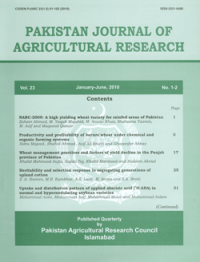EFFECT OF SEED PRIMING ON GERMINATION PERFORMANCE AND YIELD OF OKRA ( L.)
Inayat-Ur-Rahman*, Shamsher Ali**, Mukhtar Alam*, Mohammad Adnan*, Hidayat ullah*, Muhammad Faisal Anwar Malik*, Abdul Sattar Shah* Mohammad Ibrahim*
ABSTRACT
To overcome the problem of slow and erratic emergence in okra, two experiments, i.e., laboratory and field were carried out during 2013. In the laboratory experiment, okra seeds were primed in PEG-8000 (polyethylene glycol) and Mannitol solutions (0, -0.4, -0.8, -1.2, -1.6, -2 and -2.4 Mpa osmotic potential) for 6, 12, 18 and 24 hours while dry seeds were used as control. Same primed seeds were used in the field experiment. Priming proved effective in improving percent germination and reducing the mean germination time (MGT) as compared to unprimed seeds. Priming agents, its osmotic potential and duration significantly affected germination percentage, which increased as osmotic potential lowered from 0 to -1.2 Mpa while further lowering osmotic potential to -1.6 Mpa and below adversely affected germination. Similarly, germination percentage significantly enhanced as priming duration increased from 6h to 12h but further increase in duration from 12h to 18h caused insignificant increase in germination percentage. Increase in priming duration beyond 18h, however, resulted in non-significant decrease in percent germination. Amongst priming agents, PEG gave better germination than Mannitol, however, priming agents were ineffective in lowering MGT. Increase in osmotic potential from -2.4 to 0 Mpa and duration from 6h to 24h caused significant reduction in MGT. Field experiment results showed significant improvement in yield from primed seeds as compared to unprimed seeds. Seeds primed with PEG gave significantly a higher yield than Mannitol. Maximum yield was observed at -1.2 Mpa osmotic potential. Like MGT, days to 50% emergence in the field were unaffected by priming agent but significantly affected by osmotic potential, reduction in days to 50% emergence occurred as osmotic potential increased from -2.4 to 0 Mpa
To share on other social networks, click on any share button. What are these?







